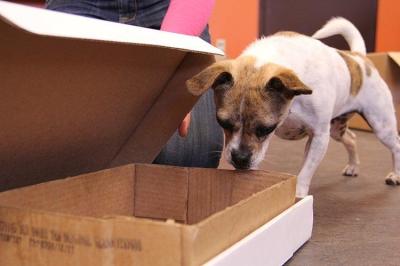
Dog Nose Work: Scent Training Sport for Dogs
K9 Nose Work, informally called dog nose work or scent training, is an up-and-coming canine sport. Similar to search-and-rescue work, this fun canine activity involves the dog seeking out and finding different scents hidden in various environments, both indoors and outside. You start by getting your dog excited about using their excellent sense of smell to search for a favorite toy or treat hidden in one of several boxes. As the dog gains more skill, specific target odors are introduced, and the search can be expanded to entire rooms or outdoor locations.
The sport was created in 2006 by three professional trainers who work with certified detection dogs. They developed K9 Nose Work because they thought everyday companion dogs could also benefit from the joys of scent work.
What are the benefits of dog nose work?
Benefits of dog nose work include physical activity, mental stimulation, and confidence building. For both the dog and the handler, nose work is a great way to bring their relationship to the next level. In fact, scent training is being used more and more to provide enrichment for dogs in shelters. Engaging in nose work helps keep dogs mentally healthy while they’re waiting for homes, and it can even be a marketing tool that helps them get adopted.
What type of dog can do scent training?
The beauty of nose work is that virtually any dog can do it, including dogs who can’t take part in more vigorous exercise because of age or physical limitations. Nose work training can increase the confidence of shy or fearful dogs, and it’s even suitable for dogs who are high energy, as it helps them learn how to focus.
What equipment or supplies are needed for nose work?
That’s another great thing about nose work: The only “equipment” you’ll need to get started is a supply of tasty treats and some cardboard boxes — and your dog’s nose, of course.
Home starts with you
Are there classes where my dog can learn the sport?
Absolutely. Visit the National Association of Canine Scent Work website for more information on finding nose work workshops and certified nose work instructors in your area. Instructors work with just one pup at a time, so the one-on-one classes are fine even for dogs who are reactive toward other dogs.

Are there formal competitions for K9 Nose Work?
Yes, but you must join the National Association of Canine Scent Work to begin competing in the sport. To gain eligibility to compete in the sanctioned trials, dogs must successfully complete an odor recognition test.
How do I get my dog started with nose work?
It’s easy to start teaching your dog nose work. Here’s what you’ll need:
- About six cardboard boxes
- Some of your dog’s favorite treats
- A 6-foot leash (minimum length)
Here are the steps to follow:
- Remove your dog from the working area, which could be a room in your house or a fenced backyard. You don’t want your dog to see where you’re hiding the treats.
- Lay out the boxes and bait at least half of them with a couple of smelly treats. Leave the boxes open and easily accessible to make it easier for your dog to find the goodies. The idea here is encouraging the dog to self-reward, a powerful incentive to continue the game.
- Bring the dog into the working area and let them figure out where the treats are on their own. Allow your dog to freely eat treats from the boxes. You can offer praise while your dog is eating as long as it isn't distracting.
- Bait additional boxes as your dog is searching.
- Remove the dog from the working area, and allow them to rest for a few minutes. The dog does not have to find all the treats before resting.
For each training session, repeat the steps a couple of times for a total of three to five rounds. Each round only needs to last a minute or two, with the complete session lasting about 15 minutes. You’ll want to do at least six sessions before introducing the next challenge, which could be loosely closing the boxes to make it a bit more difficult for the dog to find the treats, putting the boxes up above floor level, or nesting boxes inside boxes.
Here are some additional tips:
- Because searching is thirsty work, make sure you offer the dog some water between rounds.
- During the training rounds, don’t allow the dog to wander outside the working area.
- Avoid petting the dog while they’re searching; you don’t want to distract them.
- Keep in mind that the dog should only get rewarded by the “find.” If the dog sniffs at your treat hand, that’s OK, but don’t give any treats directly.
